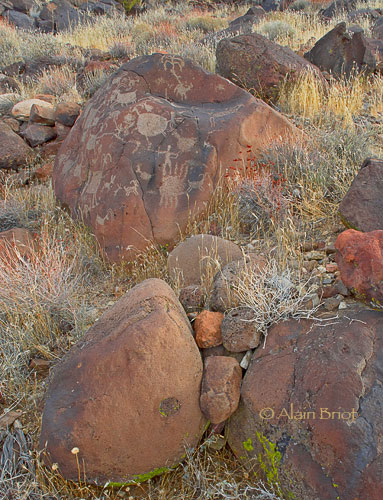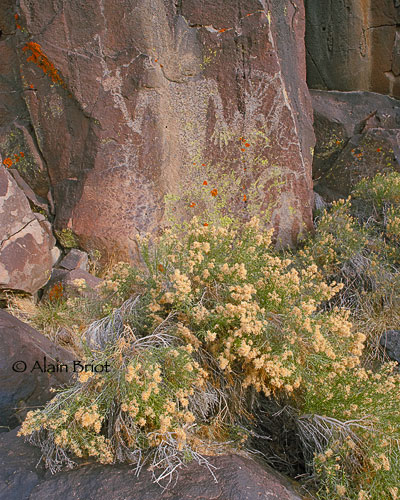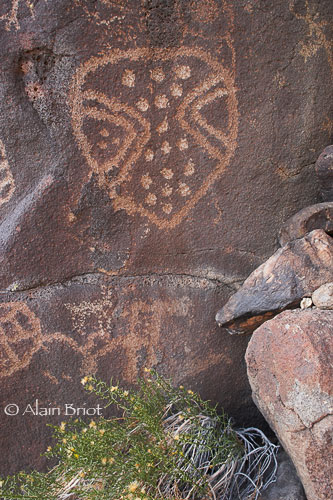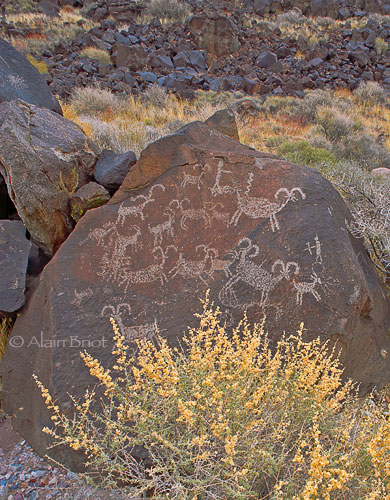
|
Introduction
In early 2004 the California Archaeological Society featured one of my rock art photographs on the 2004 California Archaeology Month poster. The photograph they selected depicts a seven foot long Bighorn Sheep petroglyph from the Coso Range in California. Petroglyphs are images carved on rocks and canyon walls, a primarily prehistoric art form which is found on all continents except Antarctica.

Why this Rock ?
Canon 1DsMk2, Canon 24 tilt-shift
Because this poster was for a non-profit organization, I offered to do a trade for the use of my photograph rather than receive financial compensation. The person I worked with, Amy, offered to take me to remote rock art sites in the Coso Range as part of this trade. I gladly accepted because, while I had previously visited and photographed the Coso Range rock art on 4 separate trips, I had not visited the locations she mentioned. Furthermore, I knew I would not be able to visit these locations without her help due to how difficult it is to access them.
The Coso Range
There are two main difficulties in accessing the Coso Range rock art sites. First, the Coso Range is a remote area where the few roads that exist are challenging even for a high clearance four wheel drive vehicle. The area is so hard to reach that, according to Amy, less than 7% of the Coso Range has actually been explored. The remaining 93% have not seen the foot of modern man. Second, most of the Coso Range, and the totality of the rock art area, is located within the China Lake Naval Weapons Station, meaning that access is highly restricted. Even when authorized, visits can be cancelled at any time if a missile test is to be conducted. While tours are organized occasionally from Ridgecrest, these tours only explore one canyon out of a total of 4. Finally, the countless open-air sites (sites located in the open range, outside of the canyons) where petroglyphs are found are visited only by professional archaeologists doing survey work for the military.

Before our Time
Canon 1DsMk2, Canon 24 tilt-shift
I have been fortunate to visit the Coso Range a total of 5 times so far. In 1998 I received the Oliver Award for excellence in Rock Art Photography from the American Rock Art Research Association (ARARA) for my Coso Range Portfolio. This portfolio, now sold out, was created in 1998 and featured 12 photographs of the Coso Rock art, a detailed description detailing each step used to process the photographs, and a CD with the digital files on it. This approach was warranted by the requirements for the Oliver Award which mandate that the photographs are both art and science, that is that they have an artistic content, being the expression of the photographer's vision, but that they can also be used for scientific purposes, that is the study of the rock art figures depicted in the photographs.
At the time I received the Oliver Award a large section of the Coso Range was still unknown to me. The trip I just completed this year remedied this situation. While I am still far from having seen the entire Coso Range (as I mentioned only 7% or so has been explored), I have now been in all the canyons that have petroglyphs, and I have visited all the major rock art sites. I am also the first to have photographed professionally the sites we visited this year.
A Diversity of Rock Art Subjects
The Coso Range features a diversity of rock art subjects, from large patterned-body anthropomorphs (human shaped) to bighorns sheep, to abstract designs consisting of straight and curves lines incised in the rock. Each canyon features one of these three categories of petroglyphs to the exclusion of just about any other subject. For example, one canyon features mainly sheep, hundreds, if not thousands of them, in various size and shapes. Other canyons feature primarily anthropomorphs, while yet other locations feature exclusively abstract patterns.
Finally, some canyons feature extremely large petroglyphs, such as the seven foot bighorn which is featured on the poster. In the canyon we visited on this expedition, we found a human-sized anthropomorph (featured above). This was the first figure I photographed on this trip, and it is one of my favorite photographs from this trip. I know when I have a favorite in the field because I photograph it with both 4x5 and 35mm digital. Such was the case in this instance.

They were Here
Canon 1DsMk2, Canon 24 tilt-shift
About my Photographic Gear
On this expedition we carried both camera systems, in two different camera backpacks, one carried by Natalie and the other by myself. In addition to my regular 4x5 and 35mm system, I also used the Canon 24mm tilt-shift lens for the first time. In fact, I received this lens the day before our trip (yes, I was lucky ;- ).
The 24TS proved to be a fantastic lens. My reasoning for purchasing this relatively expensive lens was two folds. First, the lens allows me to use the same movements as with 4x5 but in a portable system. I can use it with or without a tripod. Second, because it features a wide image circle, to allow for tilt and shifts, this lens uses only the central part of the image circle when movements are not used. This, I reasoned, should mean that a higher image quality can be expected. The lens charts said so, and I tested this lens briefly during a workshop (thank you Michael), but eventually only extended use in the field under demanding conditions provide a true answer.
I am pleased to report that this answer is positive. As they say: highly recommended ! The image quality is excellent, definitely far superior to the Canon17-40 I previously used. Furthermore, the tilt capabilities proved extremely useful when doing near-far compositions. Tilting the lens forward allows you to get both the foreground and the background in focus, thereby minimizing the need to use a small f-stop to guarantee sharpness throughout the image. With the 1DsMk2, the 24TS and an ISO setting of 300 or so, I was able to use tilts hand-held, a world-first for me since when working with 4x5 a tripod is an absolute necessity.

Bighorn Days
Canon 1DsMk2, Canon 24 tilt-shift
The problem with photographing rock art is that setting a tripod is not always possible. In the Coso Range petroglyphs are often found in piles of unstable boulders, hardly any of them level. One is lucky to find a rock where it is possible to stand without falling. In these conditions setting up a tripod is not an option. Shooting hand held while using an adjustable ISO camera and a tilt shift lens is a dream come true. It allowed me to capture high quality images I could not have captured otherwise.
The 24 TS is an incredible lens. I have heard some people say that it is not as sharp as the Canon 45 TS or 90 TS. Could be, but that would only means that the 45 and 90 tilt-shift are superlative lenses when it comes to sharpness because the 24 TS is quite good. And, keep in mind that I am using it with a full-frame digital sensor camera, on which corner softness, or distortion, are usually a problem when using Canon regular wide angle lenses.
The Expedition
We spent 3 days exploring specific areas of the Coso Range. Starting at Dawn, we proceeded to our destination starting with paved roads and continuing with a series of dirt roads less and less travelled as we moved further into the range. Sunrise or sunset photography is not possible in the Coso, because one must be in after sun up and out before sundown.
Using a GPS and a topo map, Amy was able to get us within a few hundred yards of each selected panel. Her precise knowledge of this area was a huge bonus. Usually, in an area I have not visited before, I drive to the head or the mouth of the canyon and proceed to hike its entire length, hoping to find something I want to photograph. Here, we were able to go directly to the very best locations. Once there, Natalie and I could go to work immediately, focusing on our photography. Because I favor quality over quantity, we usually photographed one, maybe two sites per day. This is not to say we didn't see a lot of rock art. We did. Because of the density of Coso Rock Art, the number of petroglyphs in a given site is very high, usually numbering in the hundreds of figures. However, the area we explored was relatively small, less than a mile long in each instance.
A Spiritual Place
The Coso Range is a unique place, one that I have been fortunate to visit more than would seem likely at first. While most photographers make a one day visit to the Coso, I have been fortunate to make 5 visits there, several of these being 2 or 3 days, and even spending a night on the range during my first visit. During my time there I met several people who later became very good friends, and my photographs of the Coso Range have been published regularly. Over time, I have assembled a unique photographic collection of the rock art found there and in doing so I have become somewhat of an expert on this location. I have no clear explanation about why this is so. It is as if the Coso is calling me, making it possible for me to visit again and again. I do know that I plan to return soon.
Alain Briot
You can see additional photographs from the Coso Range, taken during my previous visits, in my Coso Range Portfolio.
You can see additional rock art photographs in my Rock Art Portfolio.
Text and Photographs Copyright © Alain Briot 2006
All rights reserved worldwide
.
|
 |
|
|
|
|